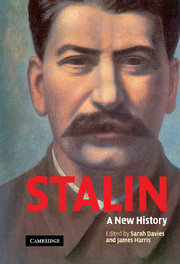Book contents
- Frontmatter
- Contents
- Notes on contributors
- Preface
- A note on transliteration
- Glossary
- 1 Joseph Stalin: power and ideas
- 2 Stalin as Georgian: the formative years
- 3 Stalin as Commissar for Nationality Affairs, 1918–1922
- 4 Stalin as General Secretary: the appointments process and the nature of Stalin's power
- 5 Stalin as Prime Minister: power and the Politburo
- 6 Stalin as dictator: the personalisation of power
- 7 Stalin as economic policy-maker: Soviet agriculture, 1931–1936
- 8 Stalin as foreign policy-maker: avoiding war, 1927–1953
- 9 Stalin as Marxist: the Western roots of Stalin's russification of Marxism
- 10 Stalin as Bolshevik romantic: ideology and mobilisation, 1917–1939
- 11 Stalin as patron of cinema: creating Soviet mass culture, 1932–1936
- 12 Stalin as producer: the Moscow show trials and the construction of mortal threats
- 13 Stalin as symbol: a case study of the personality cult and its construction
- 14 Stalin as the coryphaeus of science: ideology and knowledge in the post-war years
- Index
5 - Stalin as Prime Minister: power and the Politburo
Published online by Cambridge University Press: 24 November 2009
- Frontmatter
- Contents
- Notes on contributors
- Preface
- A note on transliteration
- Glossary
- 1 Joseph Stalin: power and ideas
- 2 Stalin as Georgian: the formative years
- 3 Stalin as Commissar for Nationality Affairs, 1918–1922
- 4 Stalin as General Secretary: the appointments process and the nature of Stalin's power
- 5 Stalin as Prime Minister: power and the Politburo
- 6 Stalin as dictator: the personalisation of power
- 7 Stalin as economic policy-maker: Soviet agriculture, 1931–1936
- 8 Stalin as foreign policy-maker: avoiding war, 1927–1953
- 9 Stalin as Marxist: the Western roots of Stalin's russification of Marxism
- 10 Stalin as Bolshevik romantic: ideology and mobilisation, 1917–1939
- 11 Stalin as patron of cinema: creating Soviet mass culture, 1932–1936
- 12 Stalin as producer: the Moscow show trials and the construction of mortal threats
- 13 Stalin as symbol: a case study of the personality cult and its construction
- 14 Stalin as the coryphaeus of science: ideology and knowledge in the post-war years
- Index
Summary
The 1930s was the time when Stalin achieved an extreme centralisation of decision-making functions in the top Party bodies and ultimately in his own hands. It was also the time when the formal supreme policy body fell into disarray and disuse. According to our literature, the ultimate institutional locus of power, the Politburo, became less and less a collective organ of decision-making. Its formal procedures and routines fell into disuse and its meetings became less and less frequent. In 1930, the Politburo met seven to eight times per month on average, but by 1936 it never met more than once per month and in three months of that year did not meet at all.
Decision-making at the top, formerly the province of the Politburo, was now carried out by informal, ad hoc subgroups of top leaders (some of them Politburo members and some not) who gathered when necessary to make decisions that then emerged as Politburo resolutions, whether or not the Politburo actually met. As these ‘small loose-knit kitchen cabinets’ replaced the Politburo, ‘procedural indeterminacy’ and ‘formlessness’ replaced structure.
Here we shall look at the changes in the Politburo in the context of the relationship between Stalin and his colleagues in order to raise questions of power at the top of the Stalinist system. We will look at the withering away of the Politburo in the 1930s in comparative perspective and in terms of ‘who decided what’ at the top, and then conclude with some reflections on power and institutions in the Stalinist context.
- Type
- Chapter
- Information
- StalinA New History, pp. 83 - 107Publisher: Cambridge University PressPrint publication year: 2005
- 2
- Cited by



